Douglas Tilden
Douglas Tilden (May 1, 1860 to August 5, 1935) was an American sculptor. He was deaf from a bout of scarlet fever at the age of four and attended the California School for the Deaf in Berkeley, California (now in Fremont, California).[1][2] He sculpted many statues that are located today throughout San Francisco, Berkeley, and the San Francisco Bay Area.
Douglas Tilden | |
|---|---|
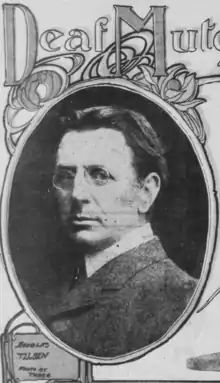 Tilden in 1903 | |
| Born | May 1, 1860 Chico, California |
| Died | August 5, 1935 (aged 75) Berkeley, California |
| Resting place | Mountain View |
Notable work |
|
| Spouse(s) | Elizabeth "Bessie" Cole
(m. 1896; div. 1926) |
Early life
Douglas Tilden was born on May 1, 1860 to Dr. William Peregrine Tilden and Catherine Maria Hecox Tilden in Chico, California. When he was four, he lost his hearing and speech after a severe bout of scarlet fever.[3]
Tilden entered the California School for the Deaf (then located in San Francisco) on January 25, 1866, studying under Theophilus d'Estrella.[3] He moved with the School to a location near the University of California, Berkeley campus at what is now the Clark Kerr Campus student residence in 1869 and graduated in 1879.[1] After graduating, he went on to attend and teach at UC Berkeley, where he studied with Francis Marion Wells. Tilden picked up sculpting in 1883, producing a small statuette entitled Tired Wrestler in 1885 which drew the attention of the board of the California School for the Deaf. The board subsequently offered him an opportunity to pursue sculpting and in 1887, he left Berkeley to attend the Academy of Design in New York, and from there, left to study art in Paris.[1] After arriving in Paris in 1888, Tilden studied under Paul-François Choppin, another deaf sculptor.[3]
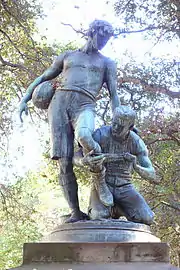
After several successful years in Paris, Tilden returned to the California School for the Deaf in 1893; however, after getting married in 1896, Tilden left the School to pursue sculpting full-time under reportedly acrimonious terms. Because his stint in Paris had been paid by the School, they felt he should continue to serve as a teacher, while Tilden felt his schooling had been a gift. In return, the California School for the Deaf confiscated one of Tilden's early artworks, The Bear Hunt, as payment.[4][5]
Career
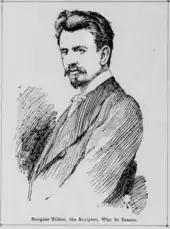
Tilden was first recognized for his sculpture while in Paris. His first exhibited work, entitled The National Game, The Baseball Player, or The Ball Player, was a sculpture of a baseball pitcher in his windup. The sculpture was admitted to the prestigious Salon event in 1889, where it won a medal.[1][6] This was followed by The Tired Boxer (exhibited at the Salon Paris in 1890), The Young Acrobat (Salon 1891), The Bear Hunt (Salon 1892), and The Football Players (Salon 1893).Albronda 1994, p. 90
Many detect a certain homoeroticism in his works because they feature young athletic men who are often unclothed. In the Football Players, many people have noted that the scene of two young football players, one is injured and resting on the shoulder of another, and the other is tenderly bandaging the wounds, shows the intimate male bonding in sports as of interdependence between the players. The gay and lesbian community has adopted the statue as representing the best ideal of the visible queer community on the Berkeley campus.[7]
He was a member of the National Sculpture Society.[8] The Football Players marked the beginning of Tilden's association with his most important patron, James D. Phelan, who commissioned Tilden's next major work after returning to the Bay Area, the Admission Day fountain installed on Market Street in 1897.
In 1901, Tilden was declared "violently insane" after an incident at his father-in-law's house where he without warning "began destroying the furniture in the room" in which his family was gathered.[9] The incident had been exaggerated by a household servant. Tilden had returned home early and, forgetting his key, had entered the house through an open window. The servant, who had been recently hired and believed this to be uncharacteristic of his employer, locked Tilden in his room, and Tilden attempted to alert others that he was trapped by hammering on the door. The frightened servant then called for the police, who took Tilden away to a mental hospital.[10] After separating from his wife Bessie in 1918, Tilden moved into his studio and worked for the Hal Roach Studio, sculpting animals for movie sets.[3]
Selected bronzes
| Name | Year | City | Location | Description/Notes | Image | References |
|---|---|---|---|---|---|---|
| The Ball Player | 1889 | San Francisco | Golden Gate Park | Tilden's first major work. Also known as The National Game or The Baseball Player. | .jpg.webp) | [11] |
| The Tired Boxer | 1890 | San Francisco | de Young Museum | Smaller version made by Tiffany & Co. of the life-size sculpture purchased by and displayed in Olympic Club, which was destroyed in 1906 San Francisco earthquake and fire. |  | [12] |
| The Young Acrobat | 1891 | Washington, D.C. | Smithsonian American Art Museum | A young baby held aloft by a disembodied arm. Previously exhibited in Golden Gate Park. | .png.webp) | [11][13][14] |
| Bear Hunt | 1892 | Fremont | California School for the Deaf | AKA The Bear Hunters. A statue of a bear protecting her cub and wrestling with two Native Americans. |  | [13][15] |
| The Football Players | 1893 | Berkeley | Strawberry Creek | One of the first permanent artworks on the University of California, Berkeley campus. San Francisco Mayor Phelan had purchased a casting of The Football Players and announced that it would be awarded to the college which won the Big Game two years in a row. After Cal defeated Stanford in 1898 and 1899, the monument was dedicated on 12 May 1900. | .jpg.webp) | [7][16][17] |
| Admission Day | 1897 | San Francisco | Market Street (at Post and Montgomery) | Part of a monument commemorating the admission of California into the United States. | _-_2.JPG.webp) | [18][19] |
| Mechanics Monument | 1901 | San Francisco | Market Street (at Battery) | It served as an inspiration for the city to rebuild itself. The fountain was removed at some point and the statue group has been moved a few feet several times. | 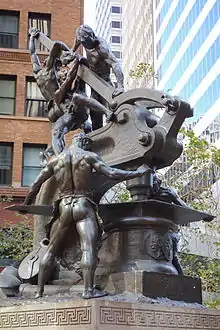 | [18][20] |
| Junipero Serra | 1906 | San Francisco | Golden Gate Park | Also donated by Phelan to San Francisco. | .jpg.webp) | [21] |
| Spanish–American War Soldier's Monument | 1906 | Portland, Oregon | Lownsdale Square | Commemorating the volunteers from Oregon who fought in the Spanish–American War. | .jpg.webp) | [22] |
| California Volunteers | 1906 | San Francisco | Market Street (at Dolores) | Commemorating the volunteers from California who fought in the Spanish–American War. | .jpg.webp) | [23] |
| Stephen M. White | 1907 | San Pedro | Cabrillo Beach | Originally installed in Los Angeles at City Hall. Received contemporary criticism as "topheavy" with a "vehement gesture". |  | [21][24][25][26] |
Personal life
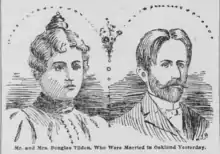
On June 9, 1896, Tilden was married to Elizabeth "Bessie" Cole, a former student of his, also deaf.[27] Although the union produced two children, a daughter Gladys (born January 5, 1900) and a son Willoughby Lee (born September 4, 1903), it was not to prove to be a happy one. Over the years Mrs. Tilden was subject to "melancholia spells" which, among things, placed a large amount of pressure on the relationship. They separated and Mrs. Tilden, who for years had managed their properties, rented out his studio to a theater group, forcing Tilden to do his sculpting in a shed.
As they grew farther apart Tilden's lawyer wrote: "Furthermore, the wife (Bessie) has knowledge of personal indiscressions [sic] in the personal conduct of Mr. Tilden which would deprive him of any capacity to stand in court, as we say, "with clean hands." Mr. Tilden claims that Mrs. Tilden has been indiscrete [sic]." The couple separated in 1918, and Bessie subsequently filed for divorce in 1924, which was finalized in 1926.[3][28]
The 'indiscreetness' in that era might have referred to his romantic relationships between men. One man in particular, Theophilus Hope d'Estrella, another artist Deaf artist, was his romantic interest as described in Tilden's diaries. These diaries were researched from Gallaudet University and Fremont School for the Deaf. D'Estrella enrolled at Freemont School for the Deaf at age 8 and later was the first Deaf person to enter UC Berkeley where he became a photographer. D'Estrella never married. Tilden and d'Estrella met at age 15 at California School for the Deaf. According to the diaries the rekindled their relationship later in life once with a camping trip in which Tilden drew pictures of each other sleeping in the tent and fishing in the nude. Tilden wrote of their nights together it was a 'very warm night'.
[29][30][31]
Gallaudet's collection also have love letters from Tilden writing from his Paris trip to d'Estrella in Berkeley. D'Estrella traveled to Paris and stayed with Tilden for a month. Upon d'Estrella's return to Berkeley he wrote over 30 letters in the newspaper the 'California News' about his travels. Some believe there are some hints to their relationship in the articles. D'Estrella, Theophilus Hope. (1889). Summer Trip to Paris. The Weekly. California School for the Deaf, Berkeley. October 26, 1889. 3. Newsletter. [32]
Tilden was found dead in his Berkeley studio on August 6, 1935.[3] He is buried in the Cole family plot of Mountain View Cemetery in Oakland, California with his ex-wife Bessie (died 1949) and Willoughby (died 1931).[33]
In 2017, the Tilden Hotel at Taylor & O'Farrell in San Francisco was renamed to honor Douglas Tilden; it originally opened as the Linden Hotel in 1928 and was renamed almost immediately to the Hotel Mark Twain.[34][35]
See also
- Granville Redmond, an artist who also studied under Theophilus d'Estrella at the California School for the Deaf and shared a room with Tilden in Paris
- Melvin Earl Cummings, a sculptor trained by Tilden
References
- Gannon 1981, p. 144 "Archived copy" (PDF). Archived from the original (PDF) on April 24, 2012. Retrieved September 6, 2011.CS1 maint: archived copy as title (link)
- Albronda 1994, p. 6
- Evetts, Rosemary; Albronda, Mildred (1996). "Guide to the Douglas Tilden Papers, 1860–1970" (PDF). The Bancroft Library, University of California, Berkeley. Retrieved September 20, 2017.
- caseykins (June 10, 2009). "Douglas Tilden: Sculptor". If My Hands Could Speak... (blog). wordpress. Retrieved September 19, 2017.
- Finacom, Steven (August 6, 2010). "Famed Deaf Sculptor Died 75 Years Ago in Berkeley". The Berkeley Daily Planet. Retrieved September 19, 2017.
- Clemans, Gayle (July 14, 2011). "'Our National Game' at SAM, through a young fan's eyes". The Seattle Times. Retrieved September 19, 2017.
- "Douglas Tilden 1860–1935". Gay Bears! The Hidden History of the Berkeley Campus. Bancroft Library, University of California at Berkeley. 2002. Retrieved September 19, 2017.
- Albronda 1994, p. 41
- "Tilden, the Sculptor, is Violently Insane". The San Francisco Call. 87 (99). March 9, 1901. Retrieved September 20, 2017.
- "Sculptor's Lost Reason Returns". The San Francisco Call. 87 (100). March 10, 1901. Retrieved September 20, 2017.
- "Beauties of the Sculptor's Art". The San Francisco Call. 69 (105). March 15, 1891. Retrieved September 20, 2017.
- Albronda 1994, pp. 3, 36
- "What California Genius Can Do". The San Francisco Call. 77 (95). March 15, 1895. Retrieved September 20, 2017.
- "The Young Acrobat". Smithsonian Institution. Archived from the original on September 21, 2017. Retrieved September 20, 2017.
- Gannon 1981, p. 143 "Archived copy" (PDF). Archived from the original (PDF) on April 24, 2012. Retrieved September 6, 2011.CS1 maint: archived copy as title (link)
- Gannon 1981, p. 146 "Archived copy" (PDF). Archived from the original (PDF) on April 24, 2012. Retrieved September 6, 2011.CS1 maint: archived copy as title (link)
- "The Football Player Is Here". The San Francisco Call. 85 (57). January 26, 1899. Retrieved September 20, 2017.
- Gannon 1981, p. 145 "Archived copy" (PDF). Archived from the original (PDF) on April 24, 2012. Retrieved September 6, 2011.CS1 maint: archived copy as title (link)
- Albronda 1994, p. 90
- Albronda 1994, pp. 61–68
- "Statue of Junipero Serra Finished by Douglas Tilden". The San Francisco Call. 99 (94). March 4, 1906. Retrieved September 20, 2017.
- Albronda 1994, p. 81
- "Monument Dedicated to Memory of California Volunteers". The San Francisco Call. 100 (74). August 13, 1906. Retrieved September 14, 2017.
- Grace, Roger M. (October 30, 2006). "Statue Goes from Broadway to Hill to Storage Yard to Grand ... to San Pedro". Metropolitan News-Enterprise. Retrieved September 20, 2017.
- "Models Magnificent Statue of Senator". Los Angeles Herald. 34 (156). March 6, 1907. Retrieved September 20, 2017.
- "Committee Approves Memorial Statue". Los Angeles Herald. 34 (205). April 24, 1907. Retrieved September 20, 2017.
- "Bound by Other Verbal Vows". The San Francisco Call. 80 (10). June 10, 1896. Retrieved September 20, 2017.
- Albronda 1994, p. 115
- Ben Lewis (April 29, 2011). "Behind the Diary: Douglas Tilden". https://journalofasl.com/douglas-tilden/. Retrieved April 29, 2011. External link in
|website=(help) - Mildred Albronda (1980). "Douglas Tilden: Portrait of a Deaf Sculptor". TJ Publisher, Inc. Retrieved April 29, 2011. Cite journal requires
|journal=(help) - Theophilus Hope d-Estrella (1882). "Illustrated History of Big Tree Camp Austin Creek Duncan's Mills". Cal. California School for the Deaf, Fremont. 2. Diary. Retrieved April 29, 2011. Cite journal requires
|journal=(help) - Theophilus Hope d-Estrella (1882). "Illustrated History of Big Tree Camp Austin Creek Duncan's Mills". Cal. California School for the Deaf, Fremont. 2. Diary. Retrieved April 29, 2011. Cite journal requires
|journal=(help) - Colbruno, Michael (December 13, 2009). "Douglas Tilden (1860–1935) – Famous Sculptor". Lives of the Dead: Mountain View Cemetery in Oakland. Retrieved September 19, 2017.
- Jebara, Paul (February 2, 2019). "Studio Tack melds art deco and wabi-sabi aesthetic at Tilden Hotel". dezeen. Retrieved January 15, 2020.
- "A Cordial Welcome Awaits Every Guest at the Hotel Mark Twain [advertisement]". Santa Cruz Evening News. January 4, 1928. Retrieved January 15, 2020.
Bibliography
- Albronda, Mildred (1980). Douglas Tilden: Portrait of a deaf sculptor. Silver Spring, Maryland: T.J. Publishers. ISBN 0-932666-03-5. Retrieved September 19, 2017.
- Albronda, Mildred (1994). Douglas Tilden: The Man and His Legacy. Seattle, Washington: Emerald Point Press. ISBN 0-9637816-0-X.
- Dabakis, Melissa (June 1995). "Douglas Tilden's Mechanics Fountain: Labor and the 'Crisis of Masculinity' in the 1890s". American Quarterly. The Johns Hopkins University Press. 47 (2): 204–235. doi:10.2307/2713280. JSTOR 2713280.
- Gannon, Jack R. (1981). Deaf Heritage: A Narrative History of Deaf America. Washington, D.C.: Gallaudet University. ISBN 978-1-56368-514-9. Retrieved September 19, 2017.
External links
| Wikimedia Commons has media related to Douglas Tilden. |
- Guide to the Douglas Tilden Papers at The Bancroft Library
- The History of the Mechanics Monument by R. Christian Anderson.
- Guidepost
- Tilden, Douglas (March 29, 1903). "Deaf Mutes and the World of Pantomime". The San Francisco Call. 93 (119). Retrieved September 14, 2017.
- Douglas Tilden at Find a Grave